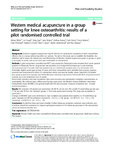Western medical acupuncture in a group setting for knee osteoarthritis: results of a pilot randomised controlled trial
| dc.contributor.author | White, A | |
| dc.contributor.author | Tough, L | |
| dc.contributor.author | Eyre, V | |
| dc.contributor.author | Vickery, Jane | |
| dc.contributor.author | Asprey, A | |
| dc.contributor.author | Quinn, Cath | |
| dc.contributor.author | Warren, F | |
| dc.contributor.author | Pritchard, C | |
| dc.contributor.author | Foster, NE | |
| dc.contributor.author | Taylor, RS | |
| dc.contributor.author | Underwood, M | |
| dc.contributor.author | Dieppe, P | |
| dc.date.accessioned | 2018-09-10T11:07:06Z | |
| dc.date.available | 2018-09-10T11:07:06Z | |
| dc.date.issued | 2016-12 | |
| dc.identifier.issn | 2055-5784 | |
| dc.identifier.issn | 2055-5784 | |
| dc.identifier.other | 10 | |
| dc.identifier.uri | http://hdl.handle.net/10026.1/12306 | |
| dc.description.abstract |
BACKGROUND: Evidence suggests acupuncture may be effective for treating the symptoms of knee osteoarthritis. Offering this in a group setting may offer cost savings. The aim of this study was to establish the feasibility of a definitive trial to assess the clinical and cost-effectiveness of Western medical acupuncture given in groups, or given individually, for adults with severe knee pain attributable to osteoarthritis. METHODS: A pilot randomised controlled trial (RCT) was conducted. Participants were recruited from seven general practices in Plymouth, Devon. Acupuncture was provided, at a dosage that increased up to and including electroacupuncture if no pain relief was reported, by one experienced acupuncturist in a community clinic. Potentially eligible adults aged at least 45 years with knee osteoarthritis were identified from practice registers, screened and randomised to either: (1) standardised advice and exercise booklet alone ('standard'); (2) booklet plus group acupuncture ('group'); and (3) booklet plus individual acupuncture ('individual'). Both acupuncture arms received up to ten treatments over 12 weeks. Recruitment, retention and data completion rates were recorded, and participants completed questionnaires on acceptability. We collected pain, stiffness and function data (using the Western Ontario McMaster Universities Osteoarthritis Index; WOMAC) and general health (EQ-5D) and economic measures at baseline and 14 weeks post-randomisation. RESULTS: We screened 149 people and randomised 60 (40 %), 20 per arm. The overall 14 week follow-up rate was 77 %, but only 70 % in the 'standard' group; 4.1 % of data points were missing. The study was acceptable to participants. Changes in WOMAC pain score (intention to treat complete case analysis) from baseline to 14 week follow-up were: 'standard', 0.4 (95 % confidence interval (CI) -1.4, 2.2, n = 14); 'group' -3.2 (95 % CI -5.1, -1.4, n = 17); 'individual' -2.4 (95 % CI -4.1, -0.7, n = 15). CONCLUSIONS: A definitive three-arm trial is feasible. Further follow-up reminders, minimum data collection and incentives should be considered to improve participant retention in the follow-up processes in the standardised advice and exercise booklet arm. TRIAL REGISTRATION: ISRCTN05305406. | |
| dc.format.extent | 10- | |
| dc.format.medium | Electronic-eCollection | |
| dc.language | en | |
| dc.language.iso | eng | |
| dc.publisher | Springer Science and Business Media LLC | |
| dc.subject | Acupuncture | |
| dc.subject | Healthcare delivery | |
| dc.subject | Knee osteoarthritis | |
| dc.subject | Pilot project | |
| dc.subject | Primary health care | |
| dc.subject | Randomised controlled trial | |
| dc.title | Western medical acupuncture in a group setting for knee osteoarthritis: results of a pilot randomised controlled trial | |
| dc.type | journal-article | |
| dc.type | Journal Article | |
| plymouth.author-url | https://www.ncbi.nlm.nih.gov/pubmed/27965830 | |
| plymouth.issue | 1 | |
| plymouth.volume | 2 | |
| plymouth.publication-status | Published | |
| plymouth.journal | Pilot and Feasibility Studies | |
| dc.identifier.doi | 10.1186/s40814-016-0051-5 | |
| plymouth.organisational-group | /Plymouth | |
| plymouth.organisational-group | /Plymouth/Faculty of Health | |
| plymouth.organisational-group | /Plymouth/Faculty of Health/Peninsula Medical School | |
| plymouth.organisational-group | /Plymouth/REF 2021 Researchers by UoA | |
| plymouth.organisational-group | /Plymouth/REF 2021 Researchers by UoA/UoA20 Social Work and Social Policy | |
| plymouth.organisational-group | /Plymouth/Research Groups | |
| plymouth.organisational-group | /Plymouth/Research Groups/FoH - Community and Primary Care | |
| plymouth.organisational-group | /Plymouth/Research Groups/Institute of Health and Community | |
| plymouth.organisational-group | /Plymouth/Research Groups/Institute of Translational and Stratified Medicine (ITSMED) | |
| plymouth.organisational-group | /Plymouth/Research Groups/Institute of Translational and Stratified Medicine (ITSMED)/CCT&PS | |
| plymouth.organisational-group | /Plymouth/Research Groups/Plymouth Institute of Health and Care Research (PIHR) | |
| plymouth.organisational-group | /Plymouth/Users by role | |
| plymouth.organisational-group | /Plymouth/Users by role/Academics | |
| plymouth.organisational-group | /Plymouth/Users by role/Researchers in ResearchFish submission | |
| dc.publisher.place | England | |
| dcterms.dateAccepted | 2016-02-06 | |
| dc.identifier.eissn | 2055-5784 | |
| dc.rights.embargoperiod | Not known | |
| rioxxterms.versionofrecord | 10.1186/s40814-016-0051-5 | |
| rioxxterms.licenseref.uri | http://www.rioxx.net/licenses/all-rights-reserved | |
| rioxxterms.licenseref.startdate | 2016 | |
| rioxxterms.type | Journal Article/Review |


